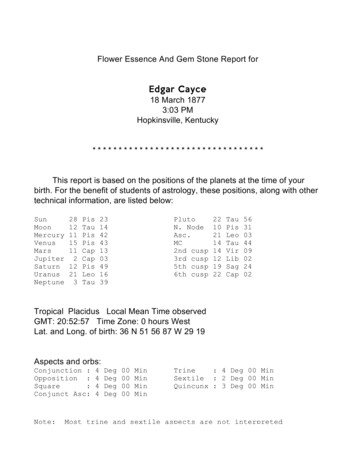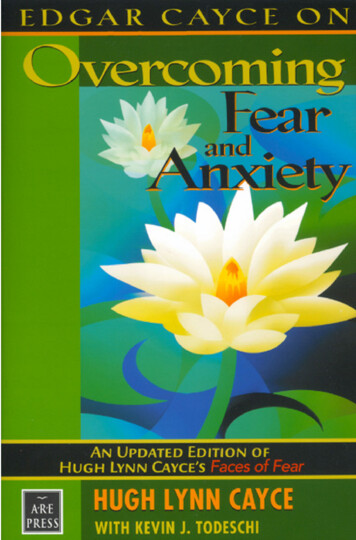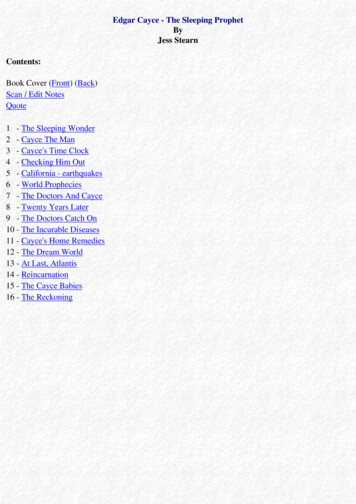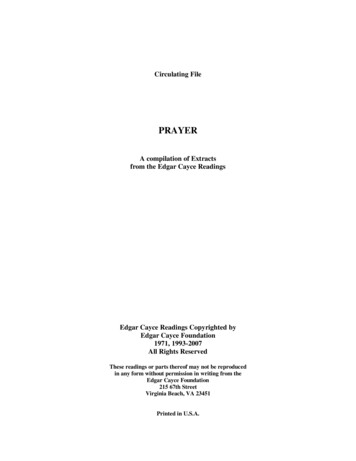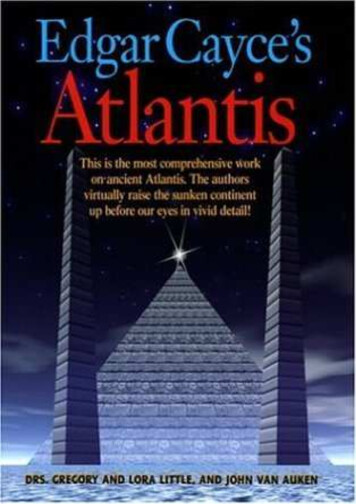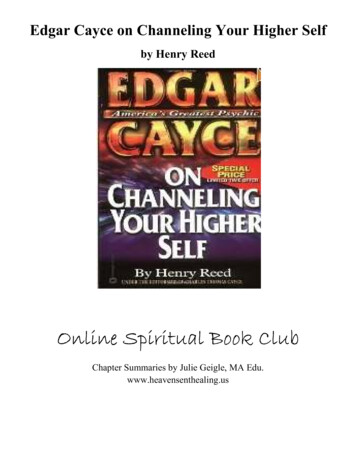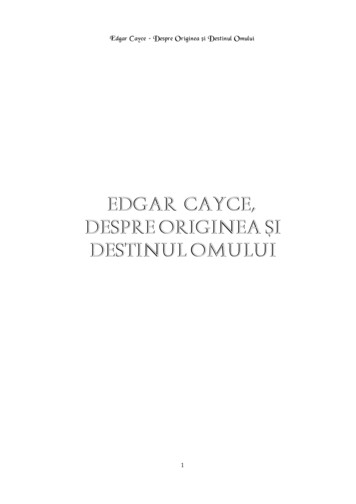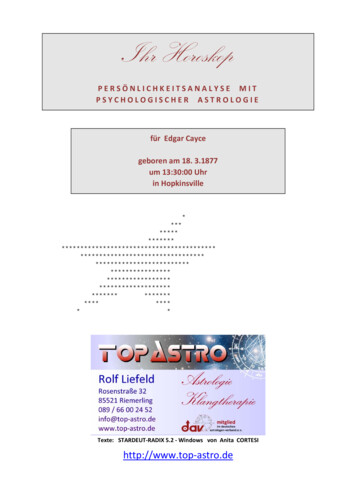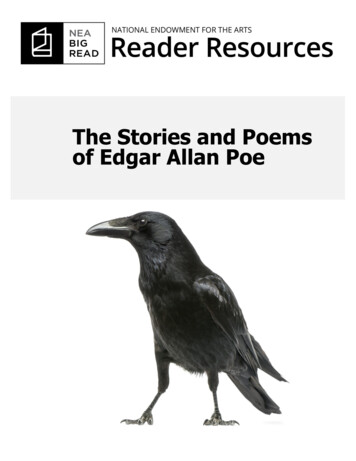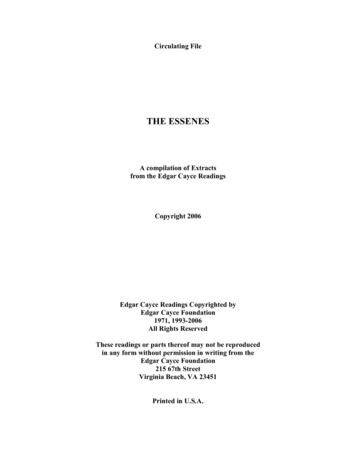
Transcription
Circulating FileTHE ESSENESA compilation of Extractsfrom the Edgar Cayce ReadingsCopyright 2006Edgar Cayce Readings Copyrighted byEdgar Cayce Foundation1971, 1993-2006All Rights ReservedThese readings or parts thereof may not be reproducedin any form without permission in writing from theEdgar Cayce Foundation215 67th StreetVirginia Beach, VA 23451Printed in U.S.A.
Essenes Circulating FileThe EssenesContentsA. Commentary by Ann Lee ClappPages4B. “The Essenes and The Dead Sea Scrolls”6C. “The Essenes And The Christ Child”Reading #1152-3 for “The Inn Keeper’s Daughter”D. Categorized Excerpts from the readings:13201. Essenes272. Essenes: Wise Men983. Sex: Female: Essenes994. Temples: Essenes995. Work: E.C.: Publications Essenes101E. Other Related material1. Articles:a. 8/2/65 Extracts from History Of Freemasonry Illustrated 38b. 2/69 “Mystery Gradually Unfolding - Scrolls Add Insight” 38c. 2/1/51 “Archbishop Claims Ancient Scrolls Prove Prophecies” 44d. 2/16/69 “Virgin Birth Support From Science”1002. Booksa. Journey to Mount Carmel edited by Violet M. Shelley102b. Edgar Cayce’s Hidden History of Jesus by Kirk Nelson 102(formerly titled The Greatest Story Never Told)c. Edgar Cayce on the Dead Sea Scrolls Glenn D. Kittler 103d. Edgar Cayce Library Series (Vol. 6) – The Christian Epoch 103e. The Essenes, A Historical Interpretationby Enid Severy Smith1043. Circulating Files:*a. Archaeology: Egypt and Gobib. Christianity and the Churchc. Judaismd. Reincarnation, Part 2: Groups*Circulating Files & Research Bulletins are available from A.R.E. membership services at(800) 333-4499 or: http: tml.Edgar Cayce Readings copyright 1971, 1993-2006 by the Edgar Cayce Foundation3
Essenes Circulating FileEssenes Commentaryby Ann Lee ClappThe Edgar Cayce readings give a unique and fascinating look into the group thatprepared the way for the coming of the Christ.Those referred to in the Cayce readings as Essenes were the outgrowth of theperiods of preparations from the teachings by Melchizedek as propagated by Elijah andother prophets for three hundred years. Their purpose was to set themselves aside tooffer themselves to be in the direct line of choice for the coming of the promised one –the Messiah. They were preparing for and expecting this event, thus the name Essenemeans expectancy. Though there were different sects of Essenes, the Cayce readingsfocus on a particular group established by Elijah called the School of the Prophetssituated on Mt. Carmel.Their studies included astrology, numerology, the return of individuals orreincarnation, and phrenology [the study of character analysis related to configurations ofthe skull]. They emphasized purity of body and mind, certain diets and communing withuniversal forces as expressed in nature. The use of intuition and the development ofpsychic ability was encouraged. Attention was given to dreams, visions and psychicexperiences. They accepted both Jews and Gentiles.Men and women were considered as equals within the order even to the extentthat a woman, Judy (reading 1472), was chosen as head of the Brotherhood at the timejust preceding the entrance of the Messiah. She had been trained at the School of theProphets and was a prophetess. Although the focus was on the Essenes at Carmel,another group was mentioned that was located on the way above Emmaus that “goethdown towards Jericho” on the northern coast from Jerusalem [Qumran?]. A womannamed Eloise (reading 1391), who had been trained at the School of the Prophets, was incharge of that community.The Essenes knew from astrology and from observing the signs in the heavens(the relation of Polaris to the southern clouds) that this was the beginning of a new cycle– the Piscean age. Twelve maidens, young children of which Mary was one, were chosento represent each of the tribes of Israel. These little girls went through very strict trainingfor a number of years. A beautiful description is given as to how Mary was designatedby an angel as the chosen one when she was about twelve years old. Mary’s furthertraining, betrothal and marriage took place at Carmel.The events at the inn in Bethlehem are very different from those which havepreviously been presented. The inn keeper and his family were Essenes and were awareof what was to take place. The readings give a beautiful and inspiring account of thisevent.After the birth, when Joseph knew it was necessary for the family to go intoEgypt, the Brotherhood prepared the way. The family traveled only at night. Their staywas near Alexandria. Mary and Josie studied in the library of Alexandria all theprophecies that had been given concerning the birth of Jesus. Josie was the maidenchosen by the Brotherhood to assist Mary and the child. When it was safe to return, afterabout four and one half years, the family went to Capernaum, where Jesus later began Hisministry.Edgar Cayce Readings copyright 1971, 1993-2006 by the Edgar Cayce Foundation4
Essenes Circulating FileJesus developed as a normal child. He was taught by Mary and Josie in the home,and by Judy, head of the Essenes, at Carmel. He was trained in the tenets of theBrotherhood as well as in Mosaic law and in ancient teachings of the east from Persia,India and Egypt.Judy determined where Jesus would travel and study. In His teens, He first wentto Persia, then to India and finally to an Essene school in Egypt. Jesus remained in Egyptuntil His final initiation in the Great Pyramid in the same rites as were set 10,500 yearspreviously during the time of Ra Ta in Egypt. Then Jesus returned to Palestine and wasbaptized by His cousin, John, who had also trained in Egypt and was initiated in thePyramid. John had returned before Jesus to prepare the way for Him.The Essenes continued during Jesus’ lifetime but how long after that is not given.Though their purpose had been fulfilled with the coming of the Master, the School of theProphets may have remained as a school to study the tenets and practices of theBrotherhood and the teachings of the east.The Master came when the cycle changed to the Piscean age. This is thebeginning of a new cycle, the Aquarian age. It is prophesied that He will come again inthis age, not as one born but will appear in the flesh to walk and talk with those of everyclime. We can be present day Essenes to help hasten that day by practicing kindness,mercy, patience, the fruits of the spirit and by living that which Jesus taught-- to love Godwith all your heart, and your neighbor as yourself. We must seek to know Him withinour own hearts before we may expect to know Him when He walks the earth again in theflesh to call His own by name.Edgar Cayce Readings copyright 1971, 1993-2006 by the Edgar Cayce Foundation5
Essenes Circulating FileThe SearchlightVol. X, No. 10October 1958The Essenes and The Dead Sea Scrolls*by Lytle W. RobinsonWhen the Dead Sea Scrolls were discovered in caves not far from Bethlehem inPalestine, the news of their contents detonated a chain reaction among scholars that willbe many years in subsiding. Indeed, the controversy may rage for decades.It has been variously estimated that it will take from ten to fifty years to decipherall the uncounted thousands of encrusted manuscripts and fragments of copper, leatherand papyrus. As they are published from time to time, the debate about their significanceis almost certain to grow in intensity.Although there are some rather large areas of speculation and disagreement aboutthe scrolls, there is one point on which men of science almost unanimously agree: that is,their source. Undoubtedly the writers or at least the keepers of these scriptures were theEssenes, a group which flourished during the first stages of Christianity. Theannouncement of this fact immediately thrust into controversial prominence this littleknown and almost forgotten sect of Hebrew ascetics. And it is around them that much ofthe contention revolves.The mystery of the Essene brotherhood has intrigued scholars for many centuries;but with the discovery of the Scrolls, the Essenes have suddenly become quite important.The public’s thirst for information about the Scrolls has been whetted. Who were theEssenes? What were their beliefs and practices? What connection, if any, did Jesus ofNazareth have with them? Could He have been a member of the order? If so, how muchdid their doctrines influence His teachings? And there is also that enduring question:Where was He and what was He doing the first thirty years of His life?Although something was known of the Essenes before the Scroll discoveries,much still remains unknown. Certainly a great deal more will be established after all themanuscripts and fragments have been deciphered. Until then, the missing gaps loomrather large in comparison with the whole cloth. Nevertheless, striking similaritiesalready have been found between the doctrines of the brotherhood and the earlyChristians.Translations have thus far been made of: a script of the Old Testament Book ofIsaiah; a scroll called The Thanksgiving Psalms; a Manual of Discipline for thebrotherhood; a commentary on the Book of Habakkuk which includes references to aMessiah and a “Teacher of Righteousness”; a commentary on Psalm Thirty-Seven; acommentary on Nahum; commentary on Micah; a paraphrase of the Law: the Oration ofMoses; and a manuscript describing a “War of the Sons of Light with the Sons ofDarkness”, or the children of Belial. These scrolls bring up perplexing questions aboutthe carpenter from Nazareth.*This article and the one that follows were written before the readings were computerized. Certainpassages and reading numbers have been misquoted (corrections have been made where possible).Edgar Cayce Readings copyright 1971, 1993-2006 by the Edgar Cayce Foundation6
Essenes Circulating FileMost of our knowledge concerning the Essenes has come from three sources:Pliny the Elder, Philo and Josephus who was a Jewish historian, contemporary of Jesus.Although the accounts of these are not entirely in accord, scholars have pieced together afairly accurate but limited description of the manner of life along the Dead Sea.According to these accounts, the Essenes lived in Palestine in scattered groupsfrom about 150 B.C. until the second century A.D. The membership was composed ofadult males who led a celibate life, although at least one faction admitted women. Theyabhorred riches, worldly honors and personal gain; holding all things in common. Theirfood was of the simplest and their attire consisted of plain, long, white flowing robes.Their labor was devoted to agriculture and a few simple handicrafts. They were opposedto commerce on the grounds that it led to covetousness, and to the making of weapons ofwar. They also rejected the animal sacrifices which played so prominent a part among theother Hebrew sects - the Pharisees and the Sadducees.The order adopted young boys and brought them up as novices, admitting them tothe group upon maturity, if they so desired. It also received adult males who had grownweary of the trials of life, after a three-year period of probation. “Here is a people,” saysPliny, “that never dies out, yet in which there are no births; so fruitful for them is others’disgust of life.”Like the Society of Friends, the Quakers, the Essenes forbade oaths maintainingthat a man whose word needed to be confirmed by oath was not to be believed at all.Their only pledge of allegiance was to the order itself and that for which it stood. TheEssenes were so highly regarded for their integrity that outsiders considered their word asbeing sufficient in all matters.Upon admission to membership the candidates vowed, according to Josephus,“First that he will practice piety toward the Deity, next that he will observe justice towardmen; that he will wrong no one, whether of his own mind or under another’s orders; thathe will hate the unjust and fight the battle of the just; that he will forever keep faith withall men, especially with the powers that be, since no ruler attains his office except by thewill of God; that, should he himself bear rule, he will never abuse his authority nor, byhis dress or by any other external mark of superiority, allow himself to outshine hissubjects; to be forever a lover of truth and to expose liars; to keep his hands from stealingand his soul from unholy gain; to conceal nothing from the members of the sect and toreport none of their secrets to others, even though tortured to death. . . .”This is the summation of what history knows of the Essenes, and it leaves much tobe desired.Another Source of InformationThere is one other source of information, and it reveals a great deal more aboutthese godly Jews - certainly the most righteous people of their day. That source is theEdgar Cayce readings.While the nature of the evidence may cause some raising of scholarly eyebrows,the information itself appears entirely plausible and convincing. At worst, it is no morespeculative than some of the hypotheses already put forth by scholars in order toreconcile or separate - as the case may be - the historical Jesus and the order of theEssenes. This, indeed, is the very heart of the question: what is the relationship betweenJesus and the Essenes?Edgar Cayce Readings copyright 1971, 1993-2006 by the Edgar Cayce Foundation7
Essenes Circulating FileThe metaphysical philosophy emerging from the Cayce readings is complex andcomprehensive. Its code of ethics is a stern one. Although it incorporates reincarnation inthe spiritual evolution of man, it integrates the highest religious ideals throughout, and itplaces the figure of Christ at the apex of the philosophical structure.Among the thousands of questions put to the sleeping Cayce over the years, someare directly related to the present problem of Jesus and the Essenes. The answers throwconsiderable light on the subject and paint a much more complete picture of the GreatTeacher and his background th
brotherhood; a commentary on the Book of Habakkuk which includes references to a . Darkness”, or the children of Belial. These scrolls bring up perplexing questions about the carpenter from Nazareth. * This article and the one that follows were written before the readings were computerized. Certain passages and reading numbers have been misquoted (corrections have been made where possible .
